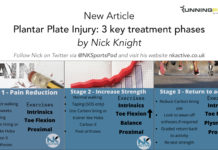Our articles are not designed to replace medical advice. If you have an injury we recommend seeing a qualified health professional. To book an appointment with Tom Goom (AKA ‘The Running Physio’) visit our clinic page. We offer both in-person assessments and online consultations.
Following on from the popularity of the first 2 parts in this toe-related trilogy (‘toelogy’?!), podiatrist Nick Knight is back with the final instalment! Having covered what orthoses are and what they do it’s on the tricky question of how they are prescribed…
Follow Nick on Twitter via @NKSportspod
So how do we prescribe orthoses?..
There are many theories, however, there are no definitive guidelines, life would be so much easier if people could come into clinic and I say you need this set of orthoses at this dosage, unfortunately, life isn’t that simple. There are certain prescription types that we can use to offload certain structures, for example, if we want to offload Tibiais posterior (muscle that runs along the medial (inside) aspect of the ankle) we can use a varus (medial) posting, however, it is important to make sure the muscles on the lateral aspect of the ankle can tolerate the increased force going through them now, as the force going through the body is a constant so we can offload one area but will increase load elsewhere.
In my opinion, there are a few crucial items we need to consider when prescribing orthoses:-
- Material – Need to make sure the material is suitable for the task.
- Weight – This is often overlooked as it determines, how the orthoses function, ie are the orthoses flexible or stiff for your weight.
- Cover – Again often overlooked, if you are aiming for control with orthoses, using a slippery cover, then the foot can slide around on the orthoses, compared to orthoses with a cover offering increased friction.
- Sport – It’s important to consider what the foot is actually doing during the sport.
- Footwear – Orthoses and footwear have to be like a married couple and work together. An example of this is Solomon running shoes, they tend to be narrow in the heel compared to other brands. Therefore trying to get the same orthoses in Solomon trainers and other trainers may not be possible and may result in the orthoses not sitting correctly in the shoe. This can lead to changes in the function of the orthoses.
The prescription of Orthoses via the use of just a pressure mat is a personal bugbear for me. The pressure mat requires the patient to walk over it with bare feet and it records and plots pressure data on a screen. I have a couple of issues with using this solely to prescribe orthotics: –
Firstly, this is a two-dimensional image and the foot is a three-dimensional item, you cannot determine arch height from this data, This is a concern as arch height is an important consideration.
Secondly, people often say we have the barefoot data now I’m going to issue a set of custom orthoses. However, it could be that your foot function is much better when in a shoe.
Custom or off-the-shelf orthoses, which are best?
Short answer, it depends on the person and what you need your orthoses to do. Some people need custom orthoses, others can be treated using shoe lining modifications. Let me elaborate. It is about finding the right tool for the right job. Custom orthoses can be very helpful, however, they do cost more than off the shelf orthoses. Off the shelf orthoses are still useful and if you find off the shelf orthoses work for you, then there is no need to change.
When looking at the research on this question we have an issue, research often shows no benefit between custom and off-the-shelf orthoses, however, the majority of studies define custom orthoses as a set of orthoses that are just moulded to your feet, not true custom orthoses. They tend not to consider shell material and thickness. So it could be argued that they are not testing true custom orthoses. Another issue is that in the research people often say there was no difference between sham orthoses (control group) and the test orthoses, the issue here is that, I believe sham orthoses do not exist, as the sham device itself will have an effect on foot function as will putting flat piece of foam in the shoe, so the study is flawed from day one, also every person will react differently to the sham device.
If you have a foot that is maximally pronated they are less likely to tolerate off-the-shelf orthoses as there may be an increased risk for them being uncomfortable within the arch the foot, however, I do have many patients who have a maximally pronated foot and use off the shelf orthoses very well. So answering the question which type is best is very difficult to answer and is a very case-by-case basis and also depends on the experience of the person prescribing the orthoses and making sure they get the prescription correct for you.
Orthoses and Strength work
I personally always give strengthening exercises when issuing orthoses, the reason for this that the majority of running injuries I see in clinic are due to a load management issue, my goal with orthoses is to reduce the load going through the injured structure, however, we can also give exercises to help strengthen the structure. This increases how much load it can tolerate, effectively giving a bigger window to play with before you get injured again. It is also important to look at proximal (hip) control if there is hip weakness, it may reduce the effectiveness of the orthoses and may reduce the tolerance of the orthoses. It is important when prescribing orthoses to not just look at the foot however to look at the lower limb as one. If there is weakness noted it is important to get this addressed and this highlights the importance of team working between healthcare professionals.
Summary
We know that orthoses do work and for a lot of people they are extremely successful, however, I feel we need to change the way we view them. We need to be looking more at using orthoses as part of a treatment plan, working towards a treatment goal where orthoses may be short term or even changed and modified at a later date. Different orthoses are needed for different footwear and for different sporting activities. Hopefully, we can start to change views that orthoses are fit and forget, and start to view them as a tool that can be very helpful part of the rehabilitation process.
For more from Nick Knight check out his excellent UKRunchat Blog.











[…] Orthoses – so much more than ‘fit and forget’ Part 3 – by Nick Knight […]
Nick:
Another great article. You are to be commended on a very well-written series which, I believe, accurately describes the biomechanical nature and clinical use of foot orthoses.
Foot orthoses, whether they are over-the-counter or prescription foot orthoses, all work in the same fashion: they alter the magnitudes, temporal patterns and the discrete locations of the reaction forces acting on plantar foot. It is really that simple. I believe that the more we, as a profession, describe foot orthosis function in terms which are already accepted within the international biomechanics community, then we will be moving forward in our understanding of how they work for all of our patients. It is good to see you, Nick, carrying the torch forward educating our colleagues in other health-related professions with such well-written articles.
Your comments on foot orthosis research were excellent and the problems you mentioned with foot orthosis research is one of my biggest frustrations with reading these articles within the scientific literature. Well-trained sports podiatrists don’t just give up when an orthosis doesn’t work for the patient. Rather well-trained sports podiatrists will attempt to modify that foot orthosis until it does work for the patient.
Again, thanks for the great articles and keep up the excellent work!
Have you ever seen an orthosis research study that allowed the orthosis to be modified after it’s initial fitting? I haven’t. However, that is how I, and most other sports podiatrists function in the real world and is the reason why these in-shoe devices are called **custom** foot orthoses. Until researchers realize, that in order to optimize foot orthosis function, foot orthoses may need to be modified by an experienced clinician during the course of the experiment to optimize orthosis function, then research will seriously underestimate the potential therapeutic benefit of custom foot orthoses.
Nick:
Another great article. You are to be commended on a very well-written series which, I believe, accurately describes the biomechanical nature and clinical use of foot orthoses.
Foot orthoses, whether they are over-the-counter or prescription foot orthoses, all work in the same fashion: they alter the magnitudes, temporal patterns and the discrete locations of the reaction forces acting on plantar foot. It is really that simple. I believe that the more we, as a profession, describe foot orthosis function in terms which are already accepted within the international biomechanics community, then we will be moving forward in our understanding of how foot orthoses work for all of our patients. It is good to see you, Nick, carrying the torch forward educating our colleagues in other health-related professions with such well-written articles.
Your comments on foot orthosis research were excellent and the problems you mentioned with foot orthosis research is one of my biggest frustrations with reading these articles within the scientific literature. Well-trained sports podiatrists don’t just give up when an orthosis doesn’t work for the patient. Rather well-trained sports podiatrists will attempt to modify that foot orthosis until it does work for the patient.
Have you ever seen an orthosis research study that allowed the orthosis to be modified after it’s initial fitting? I haven’t. However, that is how I, and most other sports podiatrists, function in the real world and is the reason why these in-shoe devices are called **custom** foot orthoses. Until researchers realize, that in order to optimize foot orthosis function, foot orthoses may need to be modified by an experienced clinician during the course of the experiment to optimize orthosis function, then researchers will continue to seriously underestimate the potential therapeutic benefit of custom foot orthoses.
Again, thanks for the great articles, Nick, and keep up the excellent work!
Comments are closed.